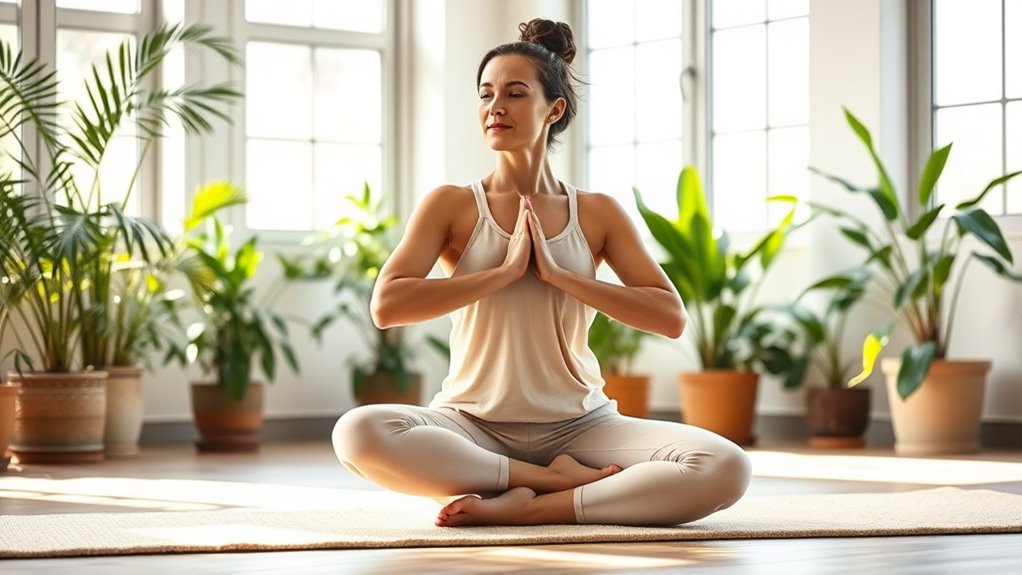To reduce joint pain and inflammation, you can practice gentle, anti-inflammatory yoga flows that focus on improving flexibility, strengthening supporting muscles, and promoting circulation. Incorporate poses like Sun Salutations, Warrior Poses, and Triangle to boost blood flow and stretch key joints. Restorative sequences using props help calm inflammation and relax muscles. If you want practical tips and safe routines to ease joint discomfort, keep exploring how targeted yoga can support your health.
Key Takeaways
- Focus on gentle, restorative yoga poses like supported Savasana and Reclining Bound Angle to reduce inflammation and soothe joints.
- Incorporate mindful breathing techniques to activate the parasympathetic nervous system and lower stress-induced inflammation.
- Use props such as cushions, blocks, and chairs to support proper alignment and prevent overstretching during gentle flows.
- Include slow, flowing sequences like modified Sun Salutations to promote circulation and synovial fluid movement in joints.
- Emphasize body awareness and controlled movements to avoid joint strain and support long-term inflammation reduction.
Benefits of Yoga in Reducing Joint Inflammation
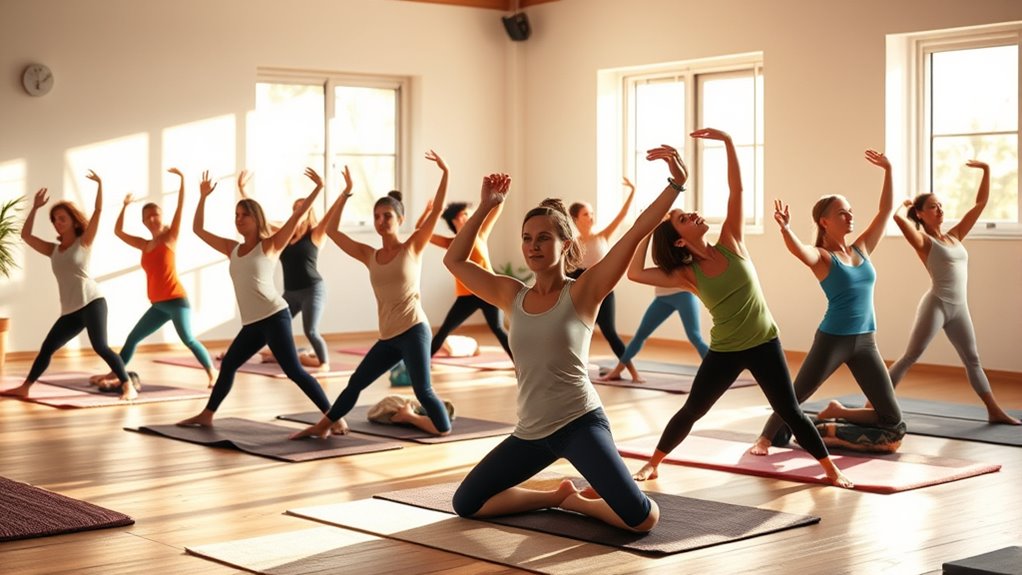
Yoga offers a gentle, effective way to reduce joint inflammation and improve overall joint health. Through specific stretching exercises, you can increase your joint’s range of motion, easing stiffness caused by arthritis. Regular practice helps your joints become more flexible, making movement easier and less painful. This gentle activity minimizes joint strain while promoting mobility, supporting better joint function over time. Many people with arthritis notice a decrease in swelling and tenderness after incorporating yoga into their routines. The low-impact nature of yoga reduces the risk of flare-ups, making it a safe option for managing inflammation. Additionally, practicing yoga can positively influence body awareness, helping you identify and avoid movements that may exacerbate joint discomfort. Cultivating mindfulness and presence during yoga sessions can enhance your ability to listen to your body and prevent overexertion. Engaging in gentle movement techniques can further support joint health and reduce stiffness. Incorporating practices that elevate spiritual energy can also boost overall well-being, encouraging a positive outlook on pain management. Furthermore, awareness of inflammation reduction strategies can enhance the effectiveness of your yoga routine. With consistent practice, you can experience long-term benefits, including less pain and improved comfort, helping you stay active and maintain your quality of life.
Essential Yoga Flows for Combating Joint Pain
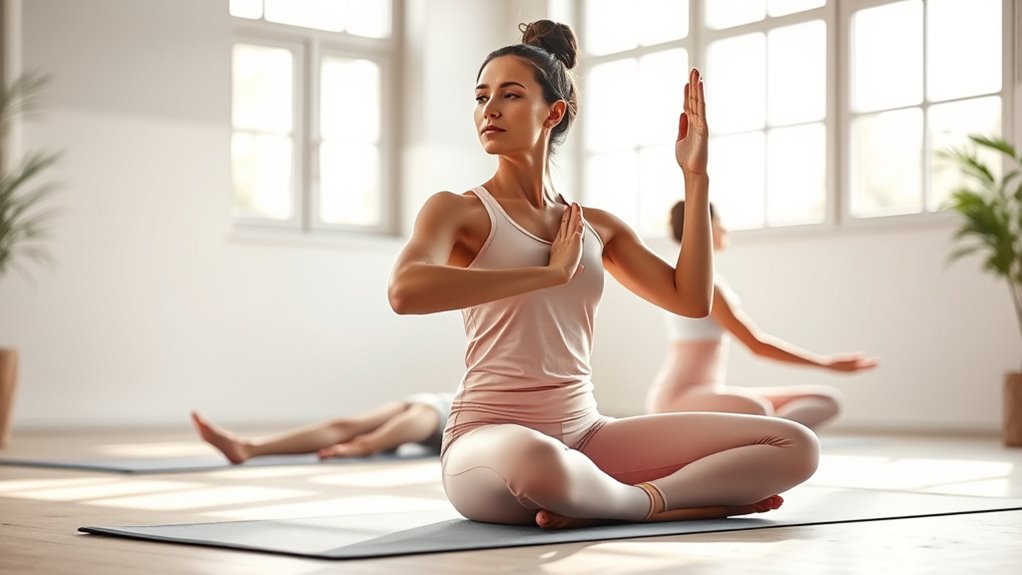
To effectively combat joint pain, incorporating gentle, targeted yoga flows can make a significant difference. Focus on styles like Hatha and Iyengar yoga, which emphasize alignment and gentle movement, reducing strain on sensitive joints. Restorative yoga uses props to support your body, allowing deep relaxation and easing joint discomfort. Use flow sequences that gradually warm up your joints, improving circulation and flexibility. Target specific areas such as knees, hips, and shoulders with focused poses like Mountain, Side Angle, and Cat-Cow stretches. Practice mindfully, paying close attention to body positioning to avoid overstressing your joints. Incorporate controlled breathing and paced movements to promote relaxation and reduce inflammation, making your practice both safe and effective in managing joint pain. Additionally, understanding contrast ratio can help you choose poses and sequences that maximize visual clarity and comfort during your practice. Recognizing the importance of vetted information ensures that you follow safe and reliable yoga practices tailored for joint health. Being aware of joint-friendly poses can further enhance your practice and minimize discomfort. Incorporating appropriate modifications can help adapt poses to your individual needs, ensuring a comfortable practice. Engaging in mindful movement can also help prevent unnecessary strain and support joint preservation during your sessions.
Sun Salutations: A Dynamic Flow for Circulation

Have you ever wondered how a dynamic sequence like Sun Salutations can boost your circulation and energize your body? This flowing practice elevates your heart rate through rhythmic, weight-bearing movements, offering a quick yet effective cardiovascular workout. It stimulates blood flow, oxygenating tissues and helping your body shed toxins. Regular practice can lower blood pressure and reduce cardiovascular risks. Sun Salutations engage major muscle groups—arms, legs, core, and back—building strength and stamina as you flow through poses like Plank and Chaturanga. They stretch muscles and joints, improving flexibility and range of motion, especially in the hamstrings, shoulders, and spine. Incorporating movement and flexibility techniques like Sun Salutations can also help reduce joint pain and stiffness, contributing to overall well-being. Additionally, these sequences can enhance joint health by promoting synovial fluid circulation within the joints. Proper breathing techniques during the sequence can further support respiratory function, enhancing overall circulation and oxygen delivery. Synchronizing your breath with movement not only improves respiratory efficiency but also fosters mindfulness, making your practice more holistic and beneficial. Plus, synchronized breathing during the sequence enhances respiratory function and supports overall circulation, leaving you energized and revitalized.
Warrior Poses to Strengthen Supporting Muscles
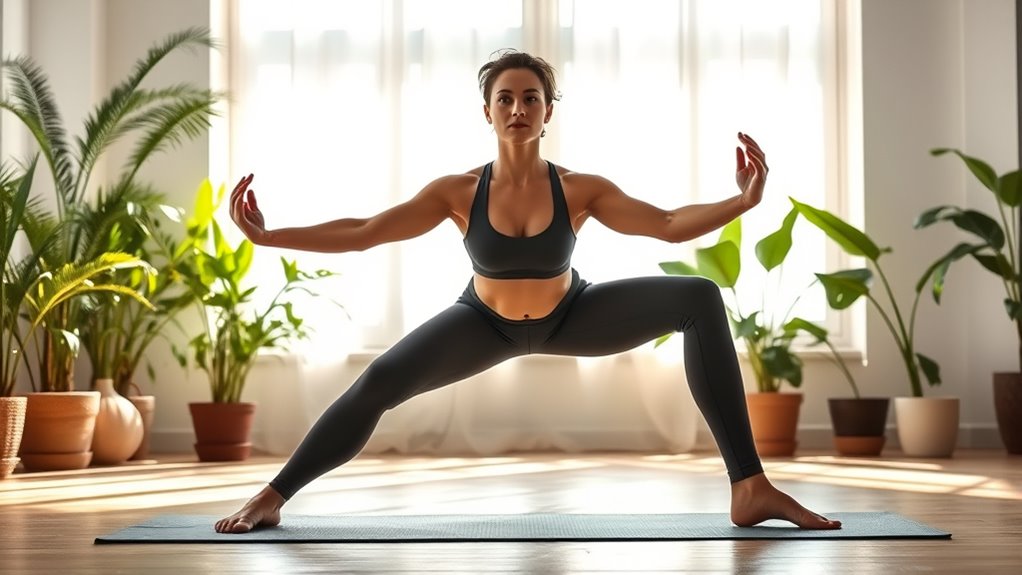
Warrior poses are powerful tools for strengthening the supporting muscles in your lower body. By practicing Warrior II, you target major leg muscles like your quadriceps, hamstrings, calves, and gluteals, which support joint stability. The lunging position engages hip stabilizers essential for maintaining proper knee and hip alignment, reducing joint strain. Regular practice builds endurance in weight-bearing muscles, improving mobility and reducing pain. These poses also activate your core and pelvic muscles, enhancing overall lower body stability and protecting joints. Using props like chairs or assistance can help you safely build strength if you’re new or have weaker legs. Warrior poses not only strengthen muscles but also open your hips, stretch hip flexors, and improve joint alignment, contributing to healthier, more stable joints.
Triangle Pose for Joint Flexibility and Stretching
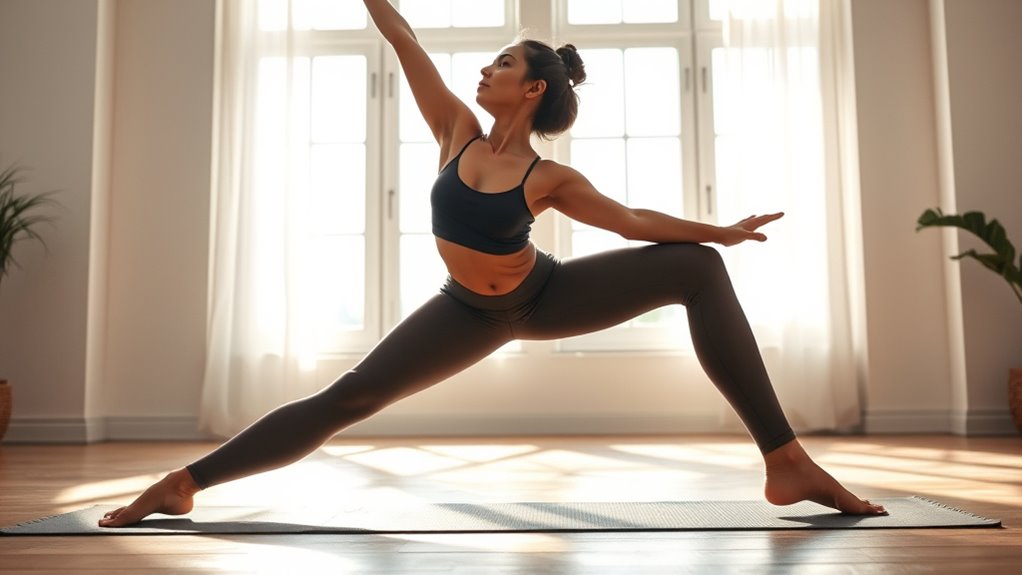
Triangle Pose is a powerful pose for enhancing joint flexibility and stretching multiple regions of the body. It stretches one side of the hip joint while compressing the other, boosting overall hip flexibility. You’ll lengthen hamstrings and groin muscles, improving your leg’s range of motion. The pose also extends and stretches shoulders, chest, and spine, increasing flexibility across key joints. By opening stiff hips through targeted elongation, you support joint health. Engaging stabilizing muscles like the quadriceps, glutes, and deep core helps stabilize and protect your joints. Proper alignment balances joint compression and stretch, promoting healthy lubrication and mobility. Additionally, increased blood flow reduces inflammation, aiding healing. Always keep your hips facing forward and monitor knee alignment to avoid strain and ensure safe, effective stretching. Incorporating this pose into your routine can also contribute to joint health by improving circulation and flexibility. Maintaining consistent practice enhances overall joint mobility, supporting long-term joint function.
Poses for Targeted Hip and Spine Relief
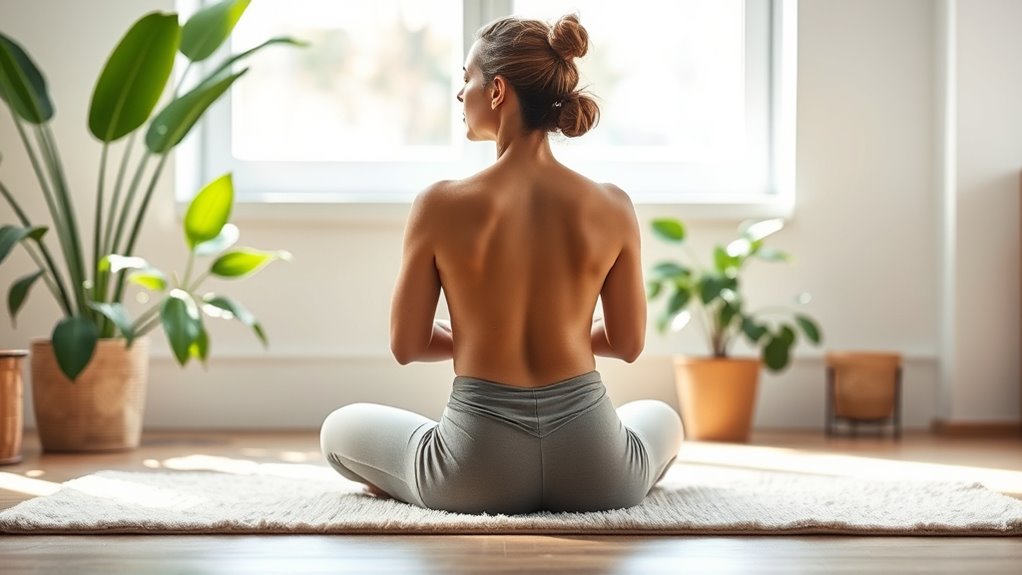
Targeted hip and spine relief can be achieved through specific yoga poses that focus on opening tight areas and strengthening supporting muscles. The Happy Baby Pose stretches and strengthens the hips, boosts blood flow, and tones hip flexors. Anjaneyasana, or Low Lunge, helps release pelvic stiffness and relieves pain. Viparita Karani, with legs up the wall, eases strain from the hips and back while encouraging circulation. Agnistambhasana, or Fire Log Pose, provides a deep stretch for hips and glutes while strengthening the groin. Reclining Bound Angle Pose relaxes the nervous system and may reduce inflammation. Incorporating safe practice techniques and using props like blocks or pillows, practicing gentle progressions, and focusing on proper alignment can enhance these benefits. Regular practice helps maintain joint mobility and reduces discomfort. Developing awareness of your body’s signals can also prevent overstretching and injury. Additionally, incorporating mindful movement can help reduce stress and further support joint health. Engaging in consistent practice and listening to your body’s limits ensures a safe and effective approach to joint care. Moreover, connecting with your inner awareness can deepen the mind-body benefits of these poses, promoting overall well-being.
Gentle Restorative Sequences for Joint Relaxation
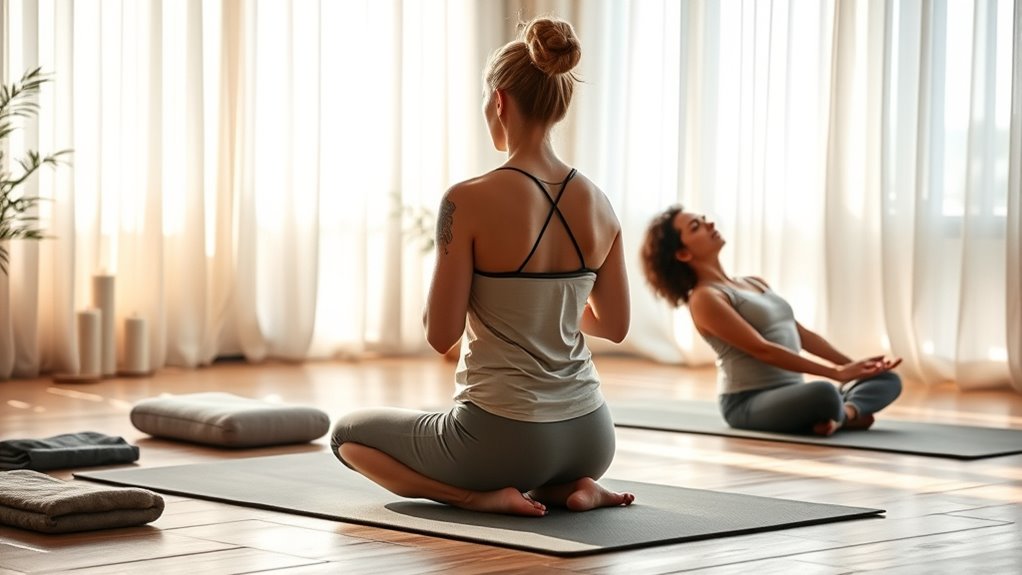
Gentle restorative sequences offer a soothing approach to joint relaxation by supporting your nervous system and reducing inflammation. By holding poses like Reclined Butterfly or Supported Child’s Pose for 5-15 minutes, you activate your parasympathetic response, lowering stress-induced joint tension and cortisol levels. These passive stretches help break the pain-stress cycle and encourage vagal nerve activation through diaphragmatic breathing. Supported poses, such as Elevated Savasana and Reclined Twist, promote cellular repair and improve circulation, essential for alleviating arthritic discomfort. If you experience an acute flare-up, adapt by using chairs or micro-movements to prevent stiffness. Always prioritize comfort, use cushions for support, and avoid deep stretches during inflammation. Incorporating gentle movement can further support circulation and joint health during recovery. Engaging in mindful breathing techniques can enhance relaxation and aid in managing pain and inflammation. Promoting a healthy blood flow is vital for nourishing tissues and reducing swelling, which is especially beneficial during recovery. Additionally, consistent practice of these gentle sequences can lead to long-term improvements in joint flexibility and resilience. These gentle sequences facilitate sustained relaxation, aiding joint health and reducing inflammation naturally.
Incorporating Props for Safe and Effective Practice
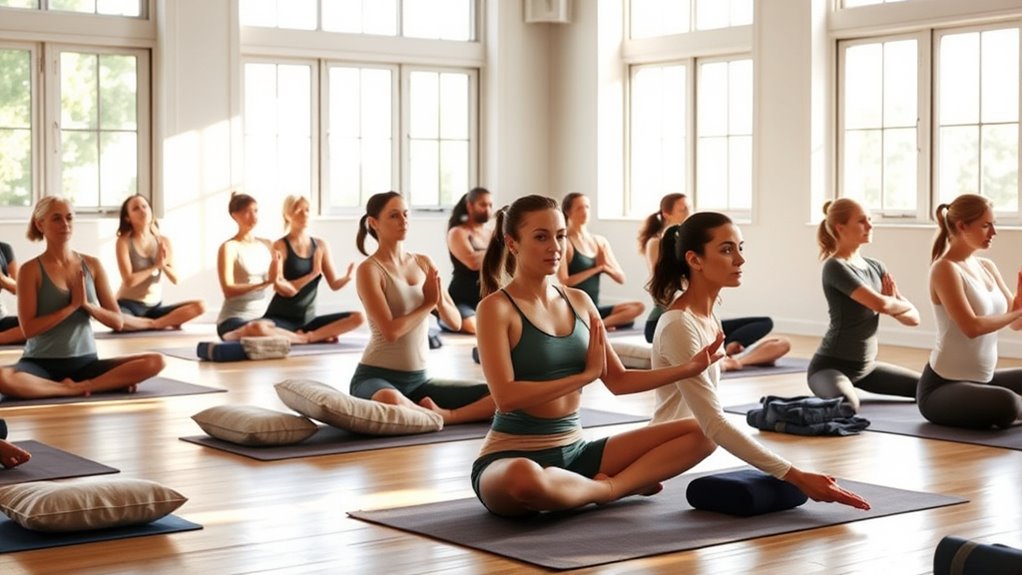
Using props in your yoga practice can substantially enhance safety and comfort, especially when managing joint pain or inflammation. Blocks support your reach, reducing strain on joints and making poses more accessible. Straps help you maintain proper alignment and prevent overstretching, which can worsen discomfort. Bolsters provide stability in restorative poses, encouraging relaxation and easing joint tension. Blankets soften pressure points, offering cushioning for sensitive areas. Chairs serve as reliable props for balance, decreasing joint stress during standing or seated poses. Incorporating these tools ensures you can modify postures to suit your mobility needs, making yoga safer and more effective. Select props made from supportive, comfortable materials, and position them correctly to maximize their benefits. Using props not only improves your practice’s safety but also boosts confidence and comfort.
Tips for Practicing Yoga Safely With Joint Pain
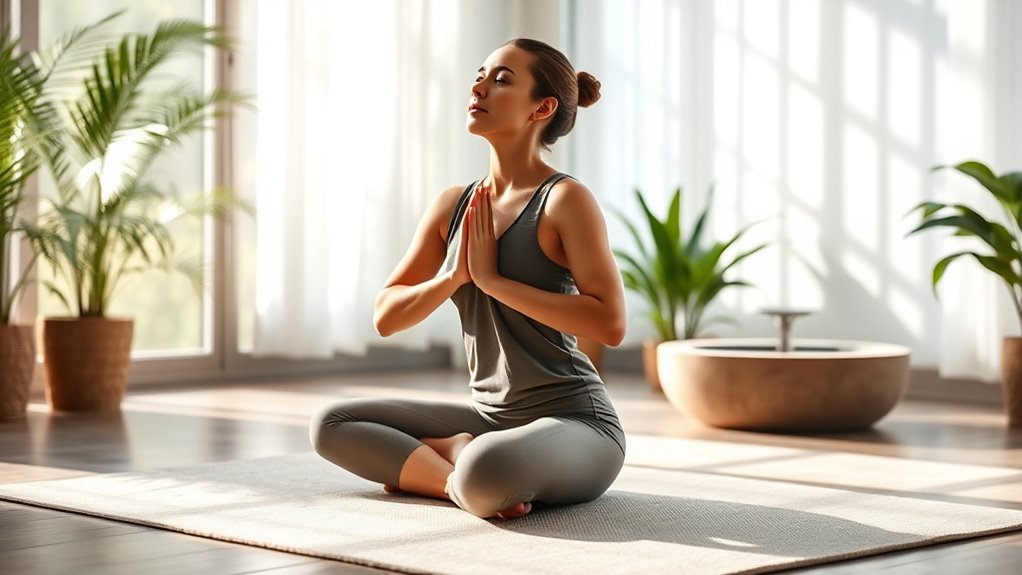
If you have joint pain, taking proper precautions can make your yoga practice safer and more effective. First, consult a healthcare professional before starting, especially if you have conditions like arthritis. Talk to a qualified yoga teacher or physical therapist for personalized modifications and safe poses. Use props like blocks and straps to reduce joint stress and support proper alignment. Choose gentle styles like Hatha, Yin, or restorative yoga, avoiding vigorous practices that can worsen pain. Always listen to your body—if a pose causes discomfort, back off or modify it. Incorporate warm-up activities, deep breathing, and joint rotations to prepare your joints. Discontinue practice if pain worsens, and keep your healthcare providers updated on your progress. Prioritize safety to enjoy the benefits of yoga without risking further injury.
Frequently Asked Questions
Can Yoga Replace Medication for Joint Inflammation?
You might wonder if yoga can replace medication for joint inflammation. While yoga helps reduce pain, improve flexibility, and boost overall function, it doesn’t target inflammation biochemically like medications do. Instead, yoga works through relaxation, gentle movement, and stress reduction. You should view it as a helpful complement rather than a substitute, especially for moderate to severe cases, and always follow your healthcare provider’s advice for managing your condition effectively.
How Often Should I Practice Yoga for Joint Pain Relief?
You might wonder how often to practice yoga for joint pain relief. Typically, practicing a few times a week works well, especially if you start with shorter sessions and gradually increase them. Consistency is key, so aim for regular practice to see long-term benefits. Listen to your body, avoid overexertion, and consider consulting a healthcare professional to tailor the frequency to your needs.
Are There Specific Yoga Styles Best for Severe Joint Issues?
For severe joint issues, you should focus on gentle, low-impact yoga styles like Hatha and Restorative yoga. These styles allow you to modify poses easily and prioritize comfort, reducing strain on your joints. Avoid intense practices like Vinyasa or Bikram unless heavily adapted. Use props to support your body, and listen to your pain signals. This approach helps improve flexibility and promotes joint health without overloading your joints.
What Should I Do if a Pose Causes Increased Joint Pain?
When a pose feels like a storm brewing in your joints, listen closely—your body’s warning signals are your compass. You should gently ease out of the pose, avoid pushing through pain, and modify it with props or by reducing depth. Rest if needed, and focus on gentle, supportive movements. Remember, patience and awareness are your best allies—honoring your body today builds strength for tomorrow.
Can Children or Seniors Safely Practice Anti-Inflammatory Yoga Flows?
You might wonder if children or seniors can safely do yoga. You can help guarantee safety by supervising children closely, using low-impact modifications, and keeping sessions short. For seniors, incorporate chair yoga, gentle stretches, and balance exercises. Always consult with healthcare providers before starting, and watch for discomfort. By tailoring poses to their needs and monitoring closely, you make yoga both safe and beneficial for both age groups.
Conclusion
By weaving these gentle yoga flows into your routine, you’re planting seeds of resilience in your joints, allowing them to bloom with renewed ease and energy. Think of each pose as a delicate brushstroke on the canvas of your well-being, shaping a masterpiece of movement and comfort. Embrace these practices with patience and compassion, and watch as your body’s symphony of strength and flexibility harmonizes anew, turning pain into a whisper of the past.
